Hard, Soft, and Hard-and-Soft Drug Delivery Carriers Based on CaCO3 and Alginate Biomaterials: Synthesis, Properties, Pharmaceutical Applications

Because free therapeutic drug molecules often have adverse effects on normal tissues, deliver scanty drug concentrations and exhibit a potentially low efficacy at pathological sites, various drug carriers have been developed for preclinical and clinical trials. Their physicochemical and toxicological properties are the subject of extensive research. Inorganic calcium carbonate particles are promising candidates as drug delivery carriers owning to their hardness, porous internal structure, high surface area, distinctive pH-sensitivity, low degradability, etc, while soft organic alginate hydrogels are also widely used because of their special advantages such as a high hydration, bio-adhesiveness, and non-antigenicity.
Here, we review these two distinct substances as well as hybrid structures encompassing both types of carriers. Methods of their synthesis, fundamental properties and mechanisms of formation, and their respective applications are described. Furthermore, we summarize and compare similarities versus differences taking into account unique advantages and disadvantages of these drug delivery carriers. Moreover, rational combination of both carrier types due to their performance complementarity (yin-&yang properties: in general, yin is referred to for definiteness as hard, and yang is broadly taken as soft) is proposed to be used in the so-called hybrid carriers endowing them with even more advanced properties envisioned to be attractive for designing new drug delivery systems.
Download the full research paper as PDF: Hard, Soft, and Hard-and-Soft Drug Delivery Carriers Based on CaCO3 and Alginate Biomaterials
or continue here
Introduction
Huang, Y.; Cao, L.; Parakhonskiy, B.V.; Skirtach, A.G. Hard, Soft, and Hard-and-Soft Drug Delivery Carriers Based on CaCO3 and Alginate Biomaterials: Synthesis, Properties, Pharmaceutical Applications. Pharmaceutics 2022, 14, 909. https://doi.org/10.3390/pharmaceutics14050909

